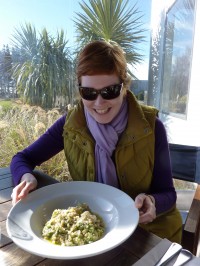
Savouring an early spring fennel risotto.
by Valerie Love
September and October have always been my favourite months of the year.
Growing up in the northeastern United States, these months marked the arrival of autumn and bright red, orange and yellow leaves on trees, fresh crisp apples and cider, and sweet pumpkin pie -some of my all time favourite things.
Here in New Zealand, September and October are just as beautiful, but instead mark the start of spring.
In Wellington, instead of the brilliant red and orange maple trees of home, we have lush green leaves, tuis feeding from the yellow blossoms of kowhai trees, and the famed springtime gale force wind.
The changing of the seasons can be an unsettling time, as our bodies adjust to changes in the environment – the gorgeous pink flowers in bloom that aggravate our hayfever, for example – as well as human-made changes to the seasons – the start of daylight savings time, and the disruption to our sleep schedule.
And as any Wellingtonian will tell you, those gale northerlies are just plain agitating!
But we can mitigate the effects of these changes by tuning into our environment and its effects on the body, and allowing that to be our guide.
According to Ayurvedic teachings, late winter into spring are classified the time of Kapha, as this time of year is generally cool and damp. Kapha combines the elements of earth and water, and includes the qualities of being slow, heavy, and grounded.
In winter, our bodies naturally seek these patterns as well. In winter, we tend to slow down, and feel the desire to sleep more since there are fewer sunlight hours. Kapha in balance allows us to feel steady, loving, grounded, and strong. When Kapha becomes out of balance in the body, we may feel sluggish or depressed, and experience an increase in sinus congestion or colds, as well as a general sense of heaviness in the body.
As spring arrives, the world around us begins to renew and revitalize.
Just as we may have a big spring clean in our homes, opening the windows and letting in fresh air, we can invite our bodies, minds, hearts, and bellies to do the same.
One of the easiest ways to align with the changing of the seasons is through the food we eat. Here in New Zealand, even in wintertime there are still heaps of local, seasonal vegetables available. At our flat, winter pumpkins, squash, kale, cabbage, broccoli, Brussels sprouts, root vegetables, and citrus fruits from the farmers market comprise the foundation for beautiful, warming winter meals.
River Cottage Veg Every Day, has quickly become my go-to vegetarian cookbook and has ideas for every veg in the garden, and over 30 pages devoted to nourishing (and very tasty!) soup recipes that are perfect for those cold, windy Wellington nights. It also includes a bounty of fresh springtime recipes for when the temperature begins to rise.
Now that spring is on the way, I’m excited to see new season asparagus beginning to appear at the markets. I’m looking forward to meals centred around baby peas and pea shoots, fennel bulbs, garlic scapes, radishes, broad beans, mint, and rocket. It’s also a good time of year for pulses, beans, and legumes.
As a general rule, springtime meals should be fresh, colourful, and lighter than winter meals. Nature provides us with heaps of vegetables just now coming into season, so allow spring vegetables to be your guide.
If you’re looking for inspiration for seasonal meals, using fresh, local ingredients from New Zealand, here are a couple of ideas from my shelf of cookbooks:
I had the pleasure of eating at Riverstone Kitchen (located outside of Oamaru) during a road trip through the South Island with my partner last year, and bought their cookbook as soon as it hit the shelves. Riverstone Kitchen: Recipes from a Chef’s Garden, is arranged by season, and the spring section includes inspiration such as broad bean risotto; and shaved fennel, baby peas and goat cheese on ciabatta.
Flipping back a few pages to the winter section, you’ll find the best recipe for Brussels sprouts for those final sprouts of the season. Truthfully, I’d never been much of a fan of Brussels sprouts, but my partner sneakily bought some sprouts from the harbourside vege market one morning while I was teaching a yoga class. I was indignant. So many lovely vegetables out there in the world, and she goes and buys Brussels sprouts when I’m not looking! But I have to tell you, Bevan Smith’s recipe for Brussels sprouts with roast almonds won me over. Seriously delicious. I like to add a bit of cabbage in with the Brussels sprouts as well, making it a vitamin and anti-oxidant powerhouse.
Another source of New Zealand seasonal food inspiration is Ripe, from the Auckland deli of the same name, which offers recipes arranged by month. The October section features my partner’s favourite salad ever, the Raw Energy salad, overflowing with fresh beetroot, carrot, and mint (which conveniently they offer the recipe to online). Other nourishing October recipes include a buckwheat and broad bean salad, a quick and easy asparagus tart, and rhubarb & raisin chutney.
While both of these books do include meat recipes, many of the recipes can be easily adapted to make them vegetarian or vegan friendly.
Over the next few weeks, as we transition into spring, I invite you to begin to observe what you’re eating, and how it makes you feel.
- Are you eating foods that fit the season, or are you eating the same foods year round?
- Are there fresh foods on your plate at each meal?
- How do you feel physically after a meal?
- How do you feel emotionally/mentally after a meal?
- How do you feel energetically after a meal?
As you answer these questions, you may begin to better understand what foods create a natural sense of well-being and prana for your body, and notice if those foods shift over time and with the seasons.


Western culture has such a fixation on foodThe world is about to starve, cities must be fed like a fat child…. I am interested in how many of you proclaimed yogis are self sustained?
Mike
Hey Mike,
What do you mean by ‘self-sustained’?
And yes, it’s interesting that many people in the West have such a convoluted relationship to food when many people in the rest of the world struggle to eat enough. I love that columns like Valerie draw our attention to our relationship to food, and help us to appreciate and understand what a gift it is to have access to fresh, nourishing food at all times of the year.
Many blessings,
KL
Hi Mike,
Unequal distribution of food in the world is a huge issue, and perhaps one that I’ll get into in a future column. But I personally believe that individuals taking small steps– such as eating more local, fresh, sustainable foods that support our natural environment– can play a role in bringing us closer to the healthier, kinder world that we’d all like to live in.